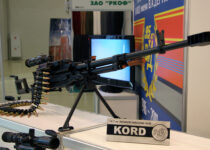Brahmos: The Past, Present And Future Of An Amazing Endeavor
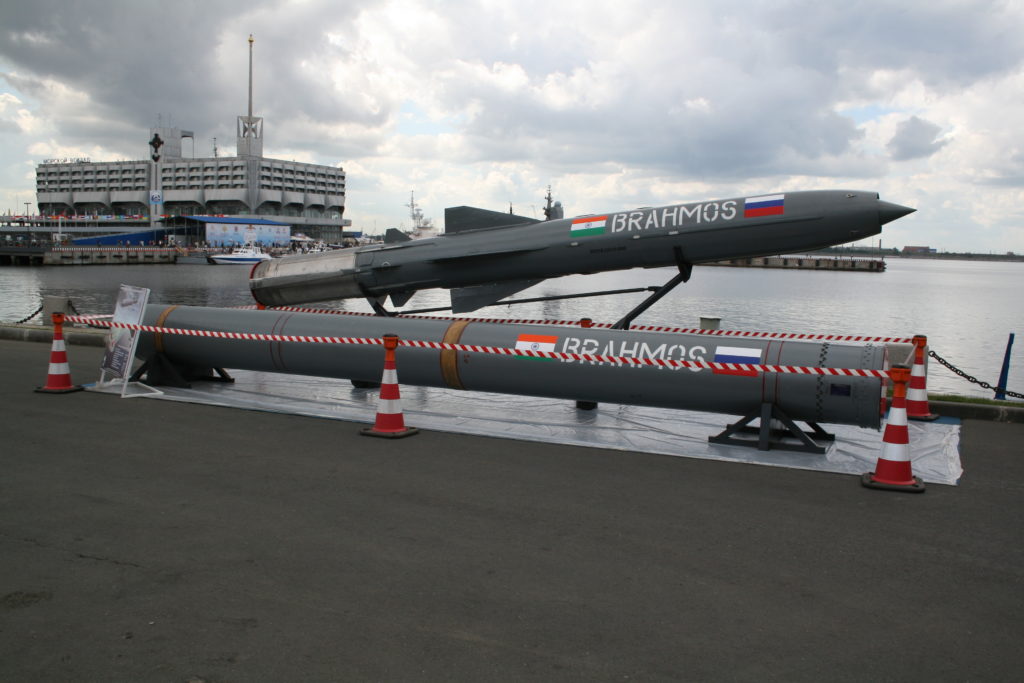
On 12 June 2001, India conducted the very first test of a missile that would come to play a central role in India’s security infrastructure. Named Brahmos, it was a result of Indo-Russian collaboration, its name derived from the fusion of the names Brahmaputra and Moskova, an Indian and a Russian river, respectively. This test would begin a long, fruitful process of development of a platform that would be used for multiple roles, like land to land, land to ship, ship to ship, submarine to ship, submarine to land, ship to land, air to ship, air to land, and even air to air. A development process that still continues to this day and will continue for the foreseeable future.
But the story of Brahmos goes much earlier in time than Brahmos itself. It starts in the 1950s, when cold war had just taken off. Both the west and the USSR had benefited from the erstwhile Nazi Germany’s technological know how that it had gained during the development of the V1, the first true cruise missile of the world. Both sides then embarked on their own paths to developed ever more sophisticated cruise missiles of their own.
The advantage of cruise missiles was that while they might not have the range and speed of ballistic missiles, they were small and flew very low and were thus more difficult to spot. In the subsequent sections, we will cover the Soviet course of cruise missile development that ultimately led to the development of Brahmos. Let’s look at the course of cruise missile development in the USSR, by looking at some iconic cruise missiles that represent the pedigree of Brahmos.
Early Development: KS-1 Komet
An interesting feature of many Soviet/Russian cruise missiles is how similar they look to some of their manned airplanes. The front section of Brahmos, for example, looks similar to the nose of a Mig-21. This is not a coincidence. Its because the Soviets actually used the air frames of their manned airplanes as the basis for developing cruise missiles.
In doing this, they exploited the fact that cruise missiles are, after all, not that different from manned aircraft. Just like manned aircraft, they use an air breathing engine and use wings and fins for achieving lift. And just like manned aircraft, they fly within the atmosphere, as their air breathing engines need air to work. Ballistic missiles, on the other hand, are based on rockets, whose engines don’t need air to work and hence they can exit the atmosphere.
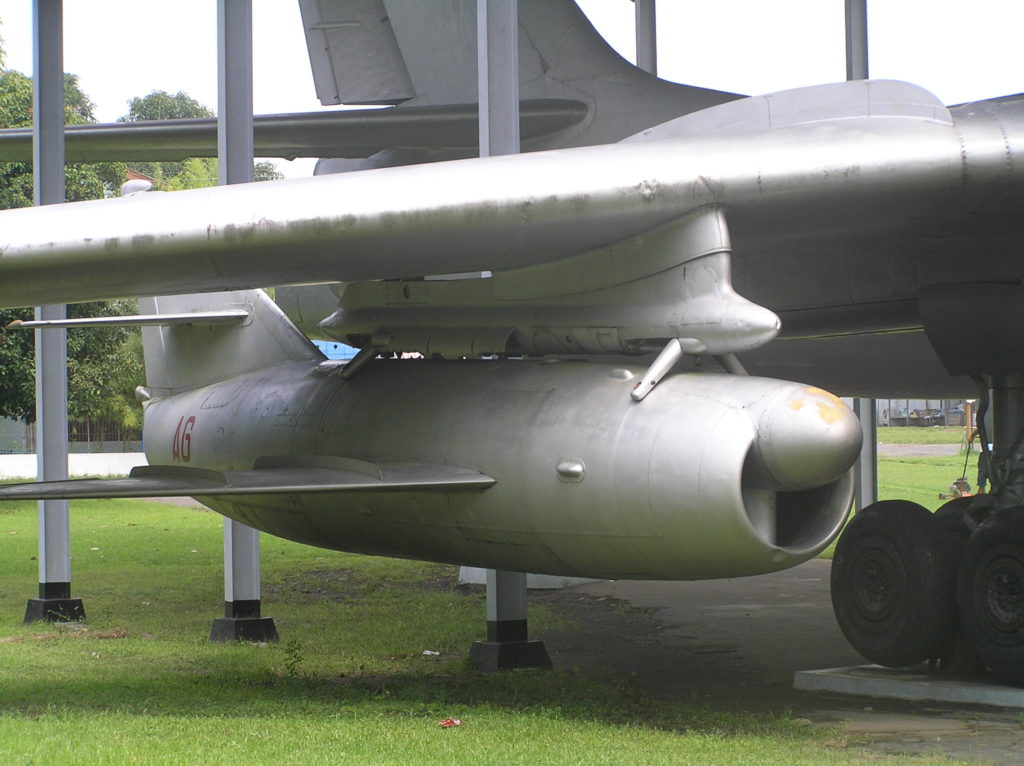
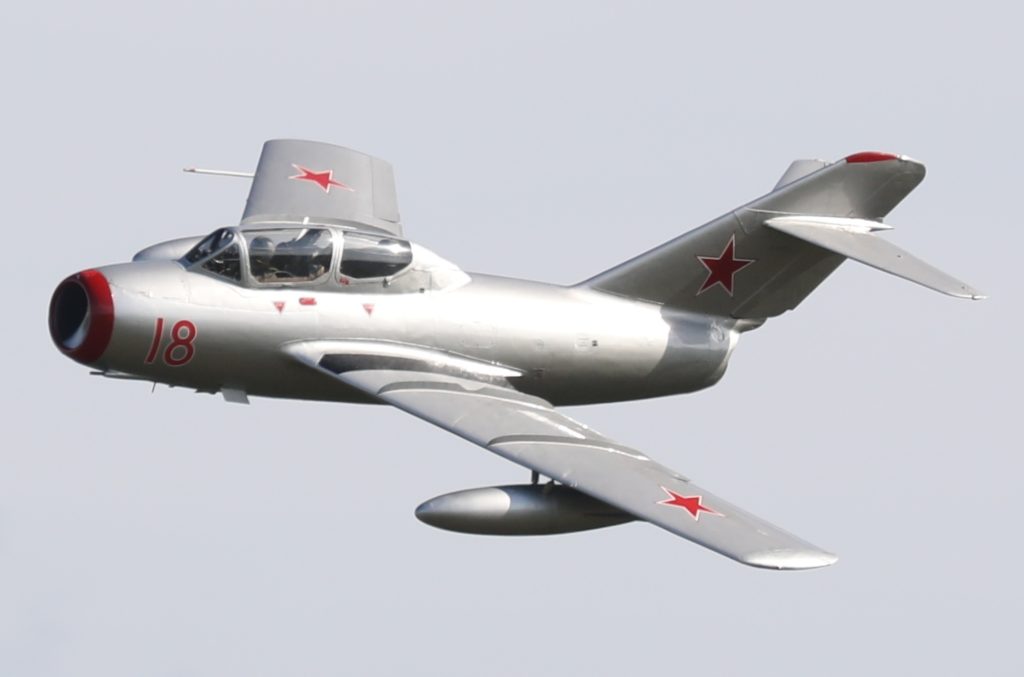
The first functional cruise missile developed by the Soviets, the KS-1 Komet, reflects this philosophy. From its outer appearance, it very much looks like an unmanned version of Mig-15. And that’s because it was the Mig-15 air frame that was used as the basis for the development of KS-1 missile. But while they are based on the air frames of manned aircraft, being unmanned themselves means that these cruise missiles are not constrained by many of the limitations that manned aircraft suffer from, because of the fact that they have to keep the fragile human inside them alive.
Hence, cruise missiles can pull far more Gs and also be way faster than manned aircraft. It is this absence of constraints that would later allow the development of highly maneuverable and supersonic cruise missiles like Brahmos. Coming back to KS-1, it was a missile designed to be launched from Tu-4 and Tu16 aircraft, and was primarily meant to be used in anti ship role. In this sense, the Soviets seemed to be adopting the Kamikaze tactics used by the Japanese pilots against American warships in World War 2, and making them less bloody and yet more effective, by using unmanned cruise missiles based on fast fighter jets, instead of slow, propeller driven, manned fighters.
Early Supersonic Cruise Missiles: P-700 Granit

As the world entered the supersonic age, the supersonic cruise missiles entered the scene around the same time as supersonic manned aircraft. One of the most iconic, and deadly, supersonic cruise missiles developed by the Soviets during this early period was the P-700 Granit, nicknamed “Shipwreck”. Designed in 1970s, this was a massive, 7000 kg missile that could fly at Mach 2.5 at high altitude and Mach 1.6 at low altitude.
It could carry a 750 kg warhead that could either be conventional or 500kt nuclear. Even with a conventional warhead, this missile could be massively destructive for a ship. Its supersonic speed coupled with its 7000 kg weight gave it tremendous kinetic energy, which by itself could rip a ship apart. On top of that, its 750 kg warhead would cause a pretty powerful explosion even with conventional explosives.
But apart from supersonic speed, P-700 had another innovative feature- it could communicate with other P-700 missiles during flight, and also receive inputs from other sources like satellites for mid course guidance. This is again similar to how manned fighter aircraft in a formation communicate with each other on radio for coordination. P-700 was designed to be fired in salvos. The missiles would cover much of their journey at high altitude to conserve fuel and maintain speed. Then, as they approached the target, they would go down to sea skimming level to avoid detection by the ship’s sensors.
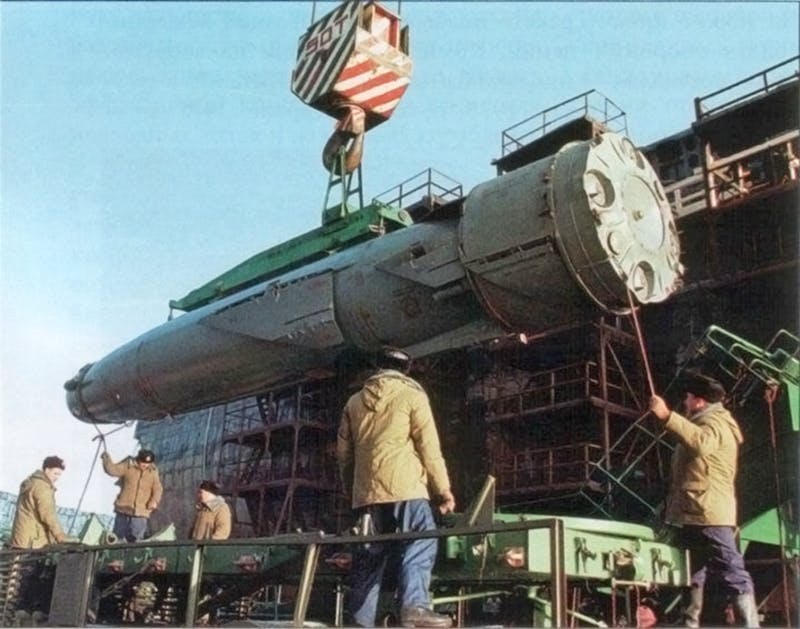
During the low level flight, one of these missiles would than pop up to detect the target ship, either through its on board radar, or through detecting the target ship’s own emissions. This high flying missile would give updated information about the target ship’s location to the missiles flying below. If it was destroyed, then another one of the low flying missiles would climb up to high altitude to take the previous missile’s place. This way, the missile swarm would stay updated about the target ship’s location while still flying below the radar horizon of the ship, until they reached the ship. The video below shows a P-700 being launched by the Russian Navy warship Pyotr Veliky.
P-700 was designed to be carried by Pyotr Veliky class battle cruisers, Oscar class submarines as well as Admiral Kuznetsov class carriers. P-700 shows another example of how the Soviets aptly utilized their technical know how of fighter jet development for development of cruise missiles. Not only does the front portion of the P-700 Granit resemble that of a Mig-21, the missiles overall size, weight and maximum speed are also comparable to those of a Mig-21. In many ways, P-700 is the grand daddy of Brahmos. It eventually led to the development of P-800 Oniks, the missile on which Brahmos is based.
P-800 Oniks/Onyx/Yakhont
In 2002, a supersonic cruise missile smaller than P-700 entered service in Russia, the P-800 Oniks. It was developed as a replacement for the P-270 Moskit, but going by its external appearance, it seems to be a direct technological descendant of the P-700. It has a maximum speed of Mach 2.5, and a 600 km max range, which is significantly longer than the 250 km range of P-270 its supposed to replace. The following statement by the U.S. Army’s Foreign Military Studies Office sums up the capabilities of P-800, many of which it has inherited from its predecessor the P-700.
“One of the Onyx missile’s most interesting characteristics is its guidance system. The guidance system can purportedly work in tandem with other missiles, and can allocate and classify targets based on their importance, and then select an appropriate attack scheme. Following the destruction of the primary target, the remaining missiles attack other ships, so no target is attacked by more than one missile.”
“After an initial target lock is achieved, the Onyx shuts down its radar and descends to a low altitude (5 to 10 meters), below the operational level of most air defense radars. Once the missile emerges from beneath the radio horizon, the radar is reactivated and locks back on to the target. This feature, in conjunction with the Onyx’s high rate of speed, greatly complicates adversarial air defense and electronic warfare countermeasures.”
Source: U. S. Army Foreign Military Studies Office. Link
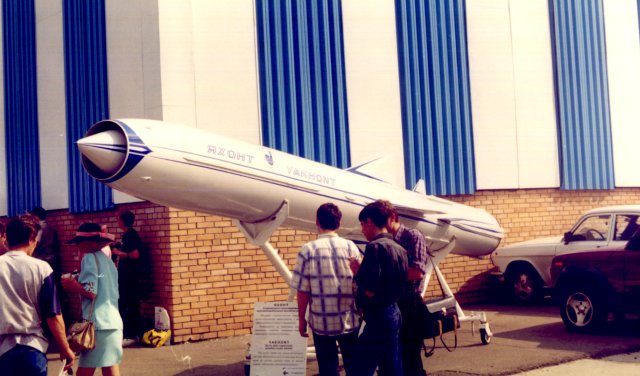
One of the advantages that P-800 has over P-700 is its smaller size, which allows it to be carried in larger numbers by warships, and not just by warships, but also by land based, truck mounted missile launchers. This has allowed the P-800 to be used in the Bastion coastal defense system. In this role, the enemy ships near the threatened coast will be scouted by Bykov-class corvettes, which will send their location to Bastion coastal defense vehicles hiding along the coastline. Based on targeting data provided by the corvettes, P-800 missiles will be fired, and once they are near the target ship, they will use their own sensors to home in on it.
While I am not sure, its possible that P-800 is also one of the cruise missiles used in the Iskander surface to surface system. This is because the transporter erector launchers (TELs) of P-800 armed Bastion system are very similar in external appearance to the cruise missile TELs of Iskander system. The smaller size of the P-800 also makes it harder to detect than the P-700.
P-800 is now being given an upgrade which will extend its range from current 600 km to 800 km. Called Onyx M, this upgraded version will also feature protection against jamming and improved guidance. While the version of P-800 being used by Russian forces is called Oniks, or Onyx, the export version of the missile is called Yakhont. The export version has been bought by Indonesia, Vietnam, Syria and Hezbollah. P-800 is also the platform, which would go on to be the foundation of Brahmos, with P-800 having entered service in 2002 and the first test of Brahmos being conducted just a year before that, in 2001.
Brahmos
Until the 80s, India was primarily focused on ballistic missile development as a part of its Integrated Guided Missile Development Program (IGMDP), which also included developing surface to air, air to air and air to surface missiles. India’s interest in cruise missile development ignited after seeing the central role that the Tomahawk and other American cruise missiles played in the initial stages of Operation Desert Storm, knocking out vital Iraqi installations like air defense nodes, command and control centers, electricity grid and power plants, without any coalition pilots having to enter Iraqi air space and without causing collateral damage.
That’s when India began discussing with Russia on joint development of future cruise missiles, and on 12 Feburary 1998, Brahmos Aerospace, a joint venture between Defense Research and Development Organisation (DRDO) of India and the Federal State Unitary Enterprise NPO Mashinostroyenia (NPOM) of Russia was founded. The word Brahmos is named after Brahmaputra, an Indian river, and Moskva, a Russian river. So, Brahmos is not just a single missile. Its part of a program to develop a whole range of different missiles. And it is in this context, that the development of the different Brahmos variants should be seen.
Before India became a member of the MTCR (Missile Technology Control Regime), the maximum range of Brahmos was officially stated to be 290 km. This was because the MTCR prevented nuclear weapons states (including Russia) from supplying to other countries, missiles who had a range of more than 300 km, and could carry a nuclear warhead. Whether the range was just stated to be less than it actually was, or whether it was actually that short and was later increased by improvements in the guidance system, is unclear.
But after joining MTCR, India has been progressively increasing the range of Brahmos. At present, the maximum range of Brahmos is believed to be 500 km. And Sudhir Mishra, the Director of Brahmos Aerospace, recently told Russia’s TASS news agency at the MAKS air show in Moscow in August 2019, that in near future a 800 km variant of Brahmos can be tested, just like the 800 km variant of its Russian cousin the P-800 was recently tested. In the coming sections, we will see the different roles in which Brahmos will be used by the Indian armed forces.
Brahmos In Surface To Surface Role
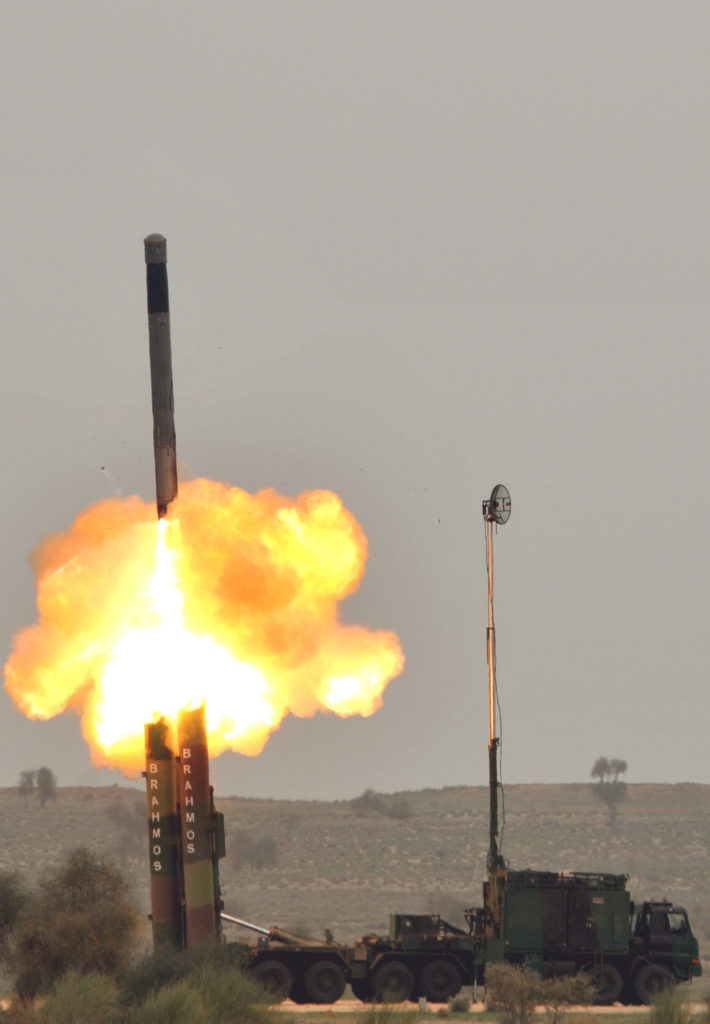
The surface to surface variant of Brahmos will be fired from truck mounted launchers and used against land targets. Here, we can make some interesting observations based on the external appearance of Brahmos transporter erector launcher (TEL). Based on the versatile Tatra 816 truck, it is known as a Mobile Autonomous Launcher (MAL). The “Autonomous” part here is interesting. Because it is a platform that combines the three missile launcher, a 40 kVA diesel driven power supply and advanced communication equipment in the same vehicle. There is also a battery capable of providing power backup for 15 minutes. The combining of these features in a single vehicle is what makes it autonomous.
An interesting thing to note is the antenna on top of the Brahmos MAL. The launchers of most other systems, be they the TELs of air defense systems like the S-400, surface to surface systems like the Iskander, or coastal defense systems like the Bastion, don’t usually have such a prominant antenna on top. This suggests that Brahmos MALs might be able to directly receive commands from external sources like communication satellites, if the command and control vehicle is taken out by the enemy. If that is indeed the case, it would make the land based Brahmos system very survivable.
Another feature of Brahmos TEL is that it carries three missiles. This is an advantage cruise missiles in general have over ballistic missiles. Because ballistic missiles are larger, usually only one of them can be carried by a TEL. Scud, Fateh, Qiam, Prithvi, Pralay, Pershing, DF-26 and DF-21 TELs are examples of such conventionally armed ballistic missile TELs. This means that to attack three different targets with conventionally armed ballistic missiles, three TELs, each carrying one ballistic missile, must be deployed. On the other hand, just one Brahmos TEL carrying three Brahmos missiles each, can attack all three targets. This means that the logistical footprint of Brahmos system is much smaller than that of a conventionally armed ballistic missile system.
This smaller logistical footprint not just makes land based Brahmos system easier to deploy, but also makes it harder for the enemy to locate Brahmos TELs on ground. This advantage is enjoyed by other cruise missiles too. For example, the TEL of land based Nirbhay missile carries four missiles each, as did the TEL of land based variant of Tomahawk missile, which was latter retired in accordance with the now defunct Intermediate Range Nuclear Forces Treaty.
Consequently, cruise missiles are more suited to conventional attack role than ballistic missiles. Ballistic missiles are more useful in nuclear attack role, as a single nuclear armed ballistic missile carried by a TEL can take out multiple targets situated in the same general area. An exception could be the anti ship variants of ballistic missiles like DF-21 and DF-26, as a single such ballistic missile could take out an enemy ship even when conventionally armed.
A land based Brahmos complex consists of four to six MALs, one mobile command post (MCP) and one mobile replenishment vehicle (MRV). Each of the three missiles in a MAL can be targeted at a different target, same target, or any other combination, depending on requirement. And all three missiles can be fired near simultaneously within four minutes of receiving command. The land targets that will likely be attacked using Brahmos are hardened air shelters (HAS), ammunition depots, fuel storage tanks, command and control centers, logistical hubs and vital bridges.
Brahmos carries a 200-300 kg unitary warhead and doesn’t carry submunitions. So it will most likely not be used against dispersed targets like military staging areas, railway martialing yards, and other instances in which you find large number of vehicles or goods spread over a wide area. To attack such dispersed targets, the platforms of choice will be Pralay and Prithvi ballistic missiles, which can carry 1000 kg of payload, including various types of submunitions, and cruise missiles like Nirbhaya, which will carry a 300-500 kg payload, again including various types of submunitions.
The maximum speed of Brahmos is Mach 3. This plays a significant role in the usefulness of Brahmos, as unlike subsonic cruise missiles, Brahmos can be used to engage time sensitive targets due to its high speed. Mach 3 is basically 1 km/sec. This means that Brahmos can cover 500 km in just around 9 minutes. Think about that for a second. Every fixed enemy instillation that’s less than 500 km from Indian border will be hit within 9 minutes of hostilities breaking out. That’s truly impressive. This high speed of Brahmos also makes it difficult to intercept. Difficulty of interception is further increased by an S maneuver that Brahmos performs right before hitting its target.
Land based Brahmos will be launched against predesignated land targets in the very first stages of a conflict, when the enemy airspace is too well protected for strike aircraft to enter, and there are targets that need to be taken out as soon as possible to blunt the enemy’s offensive operations. If for example, the enemy launches an air campaign over India, striking HAS sites, ammunition depots and fuel tanks at enemy air bases with Brahmos will almost instantly bring down the enemy’s sortie rate and slow down the air campaign.
Brahmos can not just attack enemy targets much faster than strike aircraft due to its high speed, but is also invulnerable to attacks on air bases by the enemy, unlike the strike aircraft based on those air bases, which will have to disperse and perform operations from austere air fields and even highways to escape enemy strikes. Due to its 3000 kg weight and Mach 3 speed, Brahmos hits its target with tremendous kinetic energy. This enables it to penetrate hardened structures like HAS sites and ammunition depots.
The block III variant of Brahmos also has the ability to maneuver at various points in flight and also perform steep dive from high altitude. It climbs up to a height once its near the target, and then dives down to attack the target from top. The extra kinetic energy the missile would gain during this dive would also help it penetrate hardened structures.
These land based Brahmos systems are meant to be used against targets in Pakistan as well as China. In case of China, the steep dive capability of Brahmos will also be relevant, as it enables the missile to attack targets behind high mountains in the Himalayas. In fact, according to reports, the block III variant of Brahmos will also be deployed in Aranuchal Pradesh for this very role. You can read more about how Brahmos fits in the larger picture of India’s evolving strategy towards Pakistan this previous post by me.
Brahmos In Coastal Defense Role
In August 2019, the Defense Acquisition Council approved the procurement of an undisclosed number of “Next Generation Maritime Mobile Coastal Defense Batteries” by the India navy. These coastal defense batteries will carry the anti ship variant of Brahmos, unlike the land attack variant carried by the Brahmos regiments of India Army and Indian Air Force. In other aspects, these coastal defense batteries will be similar to the land attack Brahmos system, using the same TELs, command vehicles and replenishment vehicles. It’s expected that these coastal defense batteries will at least initially be based at INS Tarta, an Indian Navy missile battery base in Mumbai, and tasked to defend the coastline of Gujarat and Maharashtra.
In coastal defense role, Brahmos is expected to work the same way as the Russian K-300 Bastion coastal defense system, which uses the P-800 Oniks, the platform on which Brahmos is based, as one of its anti ship missiles. So, its worthwhile to understand how the Bastion system works. The land attack versions of P-800 and Brahmos attack fixed targets, so they don’t need regularly updated target coordinates. But the coastal defense variants of these systems have to attack moving targets at sea, and hence the targeting information must be regularly updated using recon platforms.
As explained earlier, the Bastion system is believed to obtain target location and other details from Bykov class corvettes of the Russian navy. It is likely that Indian navy will similarly use its vessels at sea to obtain targeting information for the coastal defense batteries of Brahmos. But these naval vessels, while being capable platforms for scouting targets at sea, are themselves vulnerable to being targeted by the enemy. In future, its conceivable that an unmanned underwater vehicle or unmanned floating vehicle might take up the role of obtaining targeting information for coastal defense batteries.
The Bastion coastal defense system uses two kinds of missiles, the subsonic Kh-35 cruise missile with a range of 300 km, and the supersonic P-800 Oniks, with a range of 600 km that is now being upgraded to 800 km. In the video below, you see the TELs of Kh-35 from 0.04 mark. As you can see, each of these TELs can carry six Kh-35 missiles. At 0.10 mark, you see the P-800 TELs. From 0.22 mark, you see the Kh-35 TEL erecting the missile canisters for launch. From 0.3 mark, you see the P-800 TEL erecting the missile canisters for launch. At 0.51 mark, you see the Kh-35 missiles being launched, and from 1.01 mark, you see the P-800 missiles being launched.
As you can see from the video, the P-800 TELs carry just two missiles. This is due to the larger size of the P-800 compared to the Kh-35. The Brahmos coastal defense batteries will have TELs that carry three Brahmos missiles, just like their land attack cousins, and unlike P-800 TELs. This makes the Brahmos TELs bulkier than the P-800 TELs used in the Bastion system, which might somewhat limit the off road mobility of Brahmos TELs compared to the P-800 TELs. But like I explained before, it also helps reduce the logistical footprint of Brahmos batteries by requiring less number of TELs.
The Russians seem to prefer to maximize the off road mobility of their TELs much more than Indians, even if it means carrying less missiles per TEL. The P-800 TEL for example, is highly compact, based on the 8 wheel chassis of the MZKT-7930 Astrolog truck, has more ground clearance than Indian TELs, and carries just two missiles, which reduces its weight. The Brahmos TEL, on the other hand, is based on the 12 wheel chassis of a Tatra 816 truck, carries three missiles each, and at least from external looks, seems to have less ground clearance than its Russian counterparts.
Brahmos At The High Seas
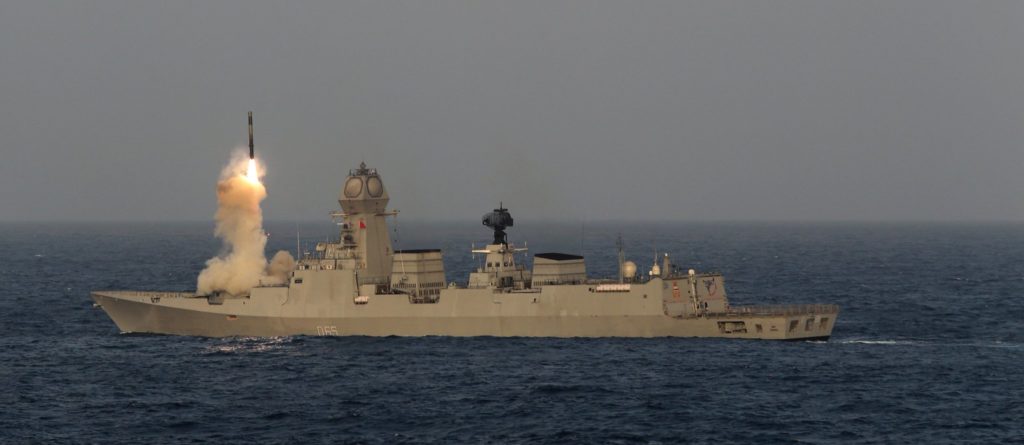
While Brahmos is now used in land attack role too, it was originally designed as an anti ship missile. In this role, Brahmos is currently carried by the Talwar and Shivalik class frigates, and Rajput and Kolkata class destroyers. Three of the Talwar class frigates, and all three Shivalik class frigates, carry 8 missiles each in VLS cells. In Rajput class, INS Rajput carries 4 missiles in inclined launchers, while INS Ranvir and INS Ranvijay carry 8 missiles in VLS cells. All three destroyers in the Kolkata class carry 16 missiles in VLS cells. In future, the seven Nilgiri class frigates will carry 8 missiles each in VLS cells, and the four Vishakapatnam class destroyers will carry 16 missiles each in VLS cells.
L&T is now producing an inclined launcher capable of accommodating four Brahmos missiles. This quad launcher could be retrofitted to many of the old warships of the Indian navy that do not have enough space to accommodate VLS cells. It is also conceivable that these quad launchers might be fitted in the Next Generation Missile Vessels, which are anti surface warfare corvettes currently under development by the Indian navy.
Brahmos is also going to be carried by submarines. Publicly available information doesn’t specify which class of submarines will carry it in the Indian navy. In Russian navy, the P-800 is carried by the Yesen class submarines and will also be carried by Oscar class submarines in the future. But the six diesel electric submarines that India plans to acquire under project 75I will almost certainly carry Brahmos, as will the six nuclear attack submarines that India is indigenously developing. Russia is offering its Amur class submarines armed with 8 Brahmos missiles each, for India’s project 75I. Amur class is an advanced version of the Kilo class. At the 1:46 mark in the video below, you can see submarine trials of Brahmos.
Many of the targets that Brahmos will be required to attack in the anti ship role, specifically destroyers and aircraft carriers, are among the most heavily defended targets on earth, armed to the hilt with decoys, EW measures, CIWS and interceptor missiles. These anti shipping missions will therefore test the limits of the missile’s capabilities. Although, it should be noted that the effectiveness of all these countermeasures, be they decoys, EW, interceptor missiles or CIWS, has not been concretely demonstrated in an actual battle so far.
In 2006, INS Hanit was hit after it failed to intercept a C-802 missile fired by Hezbollah, USS Stark was hit after it failed to intercept two Exocet missiles fired by an Iraqi jet in 1987, and in 1982, HMS Sheffield was struck by an Exocet missile fired by an Argentine Super Etendard, despite being armed against such missiles. In 2016, two anti ship missiles fired at USS Mason from Houthi controlled territory in Yeman did fail to hit the ship. But its unclear whether the ship actually intercepted the missiles or the missiles failed on their own accord. Nonetheless, at this point, a discussion of Brahmos’s strengths and weaknesses is warranted.
There are two different approaches that long range missiles can take in order to make their interception difficult. They can either be too fast to intercept or too stealthy to intercept. And these two approaches are mutually antagonistic. A cruise missile can be shaped to minimize its RCS (Radar Cross Section). But that’s usually possible only with subsonic cruise missiles. With supersonic and hypersonic cruise missiles, the need to make the shape as aerodynamic as possible interferes with the goal of reducing the RCS through shaping.
Moreover, cruise missiles also get a large part of this stealth by flying low, below the radar horizon of the enemy. But this becomes more and more difficult as the missile’s speed increases, as air resistance increases with speed and decreases with altitude. Hence, subsonic cruise missiles can usually fly much lower than supersonic cruise missiles, which in turn can fly much lower then the even faster ballistic missiles. A missile’s design usually adopts either a balance of these two approaches, or fully adopts one of them, sacrificing the other.
Subsonic cruise missiles take the stealth route, using low RCS and low altitude flight to stay undetected until its too late for the enemy. In this process, they sacrifice speed. On the other extreme of the spectrum are the ICBMs (Intercontinental Ballistic Missiles), which take the speed route, sacrificing stealth in the process. An ICBM is so unstealthy that it can be tracked all the way from its launch to its terminal phase. And yet, an ICBM is one of the hardest things to shoot down, because its terminal speed exceeds Mach 20, which is beyond hypersonic and way too fast for most interceptors to shoot down.
Supersonic cruise missiles like Brahmos fall somewhere in between these two extremes. With a maximum speed of Mach 3, Brahmos can fly much lower than ballistic missiles, giving it some degree of stealth. But it can’t fly as low as the subsonic cruise missiles, and its shape needs to be more aerodynamic, limiting the scope for stealthy shaping. Nonetheless, Brahmos does have some stealth features. Its lack of large wings (unlike subsonic cruise missiles like Tomahawk and Nirbhay), and the fact that its nose cone hides its engine blades, should reduce its RCS to some extent. So, while it might not be as stealthy as stealthy subsonic cruise missiles and fighter aircraft, it is still stealthier than 4th generation fighter aircraft.
The way speed makes a missile more survivable is by reducing the time the enemy has to intercept it. As explained before in context of P-800 Oniks, Brahmos will fly high for much of its journey, and once it detects the target ship, either with its on board radar or its passive sensors, it will descend to sea skimming altitude to stay beyond the ship’s radar horizon. Once it finally enters the horizon, it will revise the ship’s coordinates by locating it with its radar. It is estimated that once Brahmos breaks the horizon, the target ship will get just 30 seconds to intercept it.
When a well defended enemy ship is to be taken out, its likely that a salvo of multiple Brahmos missiles will be fired against it. And while the enemy ship might be armed to the hilt with interceptor missiles, not all of these missiles can be launched simultaneously. Usually there is a gap of at least 1 second between successive launches. And this limits the ship’s ability to intercept incoming missiles, especially supersonic ones. Because when a whole salvo of missiles is approaching you at supersonic speed, every single second matters. You can read more about the interplay between a Brahmos salvo and the target ship’s defenses here.
One thing that all missiles can use to make interception difficult is maneuvering to dodge the interceptor missiles. Brahmos is designed to perform an S maneuver in its terminal phase, which makes interception by CIWS (Close In Weapon Systems) difficult. And reports suggest that the recent and future upgrades of Brahmos will make it capable of maneuvering throughout its journey. Warships carry Brahmos not just for anti ship role, but for land attack role as well. In the land attack role, Brahmos will also help Indian navy with power projection, as land targets far away from Indian coasts could be prosecuted by the land attack versions of Brahmos carried by Indian warships.
Brahmos In Air To Surface And Air To Air Role
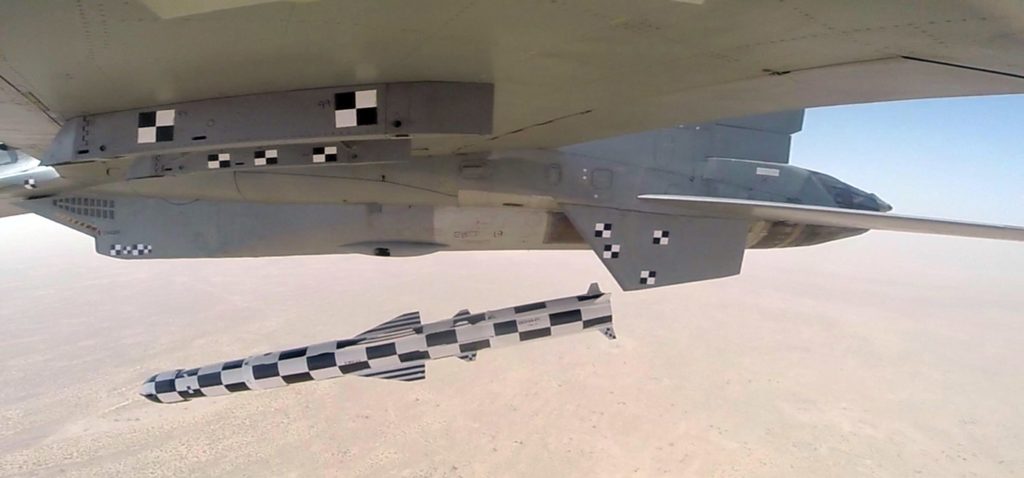
On 22 November 2017, The air to surface version of Brahmos was test launched for the first time from a Su-3oMKI. Several modifications had been made to the Brahmos, as well as to the Su-30MKI, in order to make this possible. Modifications to Brahmos included using a smaller booster (the speed of the launching aircraft made using a larger booster for acceleration unnecessary), adding fins to the booster for aerodynamic stability, and relocating the connector. Dubbed Brahmos A, this air launched version free falls for 100-150 m after being released, and goes into cruise phase at an altitude of 14,000 m. In its terminal phase, it descends to 15 m.
Just like the ship and submarine launched variants of Brahmos, this air launched variant would be used both for anti shipping missions and for land attack missions from stand off distance. In both these roles, it will make Su-30MKI a very versatile platform that can reach the theater of conflict far quicker than warships or TELs, making attacking time sensitive targets much easier.
In near future, an air to air variant of Brahmos will also be developed. This variant will supposedly have a range of 400-500 km. Like most long range air to air and surface to air missiles, the air to air variant of Brahmos will be used not against fighter sized targets, but against large, lumbering aircraft, like AWACS, maritime petrol aircraft, ELINT/SIGINT aircraft, refuelling tankers, transport aircraft and strategic bombers. Out of these, the aircraft most vulnerable to missiles like Brahmos will be the AWACS, ELINT/SIGINT and maritime petrol aircraft. This is because unlike mid air refuellers, transport aircraft and strategic bombers, these aircraft can’t fly at low altitude or stay out of the range of Brahmos while performing their missions.
In this sense, the role of air to air variant of Brahmos will be very similar to that of the 40N6E missile of the S-400 system. You can read more about this missile of the S-400 system in this previous post by me. In a typical scenario, a Su-30MKI flying at high altitude will detect the radar emissions of an enemy AWACS aircraft more than 400 km away, and launch Brahmos in that direction. Like its other variants, the air to air variant of Brahmos will use inertial guidance and mid course updates during the early and mid stage of its flight, probably receiving updates from the Su-30 that will be tracking the AWACS by detecting its emissions.
In its terminal phase, Brahmos will use its on board radar to scan the sky ahead, detect the AWACS, and proceed to slam into it. Other large aircraft, like refuelling tankers and transport aircraft, will have to be detected using the Su-30MKI’s onboard radar, or through other radars and sensors, because they don’t emit radar waves in all directions like AWACS aircraft. Su-30MKI’s N011M Bars radar has a detection range of 400 km when used in airborne early warning role. This in fact, enables the Su-30 to be used as a mini AWACS for other fighters. It is most likely by operating its radar in this role, that the Su-30MKI will detect refueling tankers and transport aircraft for launching Brahmos.
The air to air variant of Brahmos will be a true game changer, as the Su-30MKI will be able to target AWACS aircraft, refueling tankers, transport aircraft and other large aircraft deep inside enemy airspace from the safety of Indian airspace. Brahmos can be used in this role due to its Mach 3 speed, which means most aircraft can not out run it. If and when such an air to air variant of Brahmos is developed, it will be the first instance in history, of a cruise missile being used in air to air role.
Future Variants Of Brahmos
Apart from the above discussed variants of Brahmos, two other variants are being planned for the future, namely Brahmos NG (Next Generation) and Brahmos 2. Brahmos NG (also called Brahmos M) is a mini version of the present Brahmos. It will be 50% lighter and three meters shorter than the current Brahmos. The biggest advantage of this is that it could be carried not just by Su-30MKI, but also by smaller fighters like Mig-29, Dassault Rafale, HAL Tejas and AMCA. Plus, more than one Brahmos NG could be carried by a fighter due to its lesser weight and size. Its estimated that a Su-30MKI could carry 5 Brahmos NG missiles, a Mig-29 could carry 3, and a Tejas could carry two.
The smaller size and weight of Brahmos NG is being achieved through use of composite materials instead of metal where ever possible in the missile’s body, and this higher use of composites, coupled with its smaller size, will significantly reduce the RCS of Brahmos NG as well. Another advantage of Brahmos NG will be its higher speed, which would be Mach 3.5, as opposed to the Mach 3 speed of the current Brahmos. In addition, Brahmos NG will also have an AESA radar, unlike the mechanically steered radar of the current Brahmos.
The one disadvantage of Brahmos NG over current Brahmos, could be its possibly shorter range. Its not clear right now, what the maximum range of Brahmos NG will be. But its possible that the fuel capacity of Brahmos NG has been reduced compared to the current Brahmos, in order to reduce its weight and size. If that’s the case, then the range of Brahmos NG might be 300-400 km, as opposed to 500 km range of the current Brahmos, which is very likely being upgraded to 800 km.
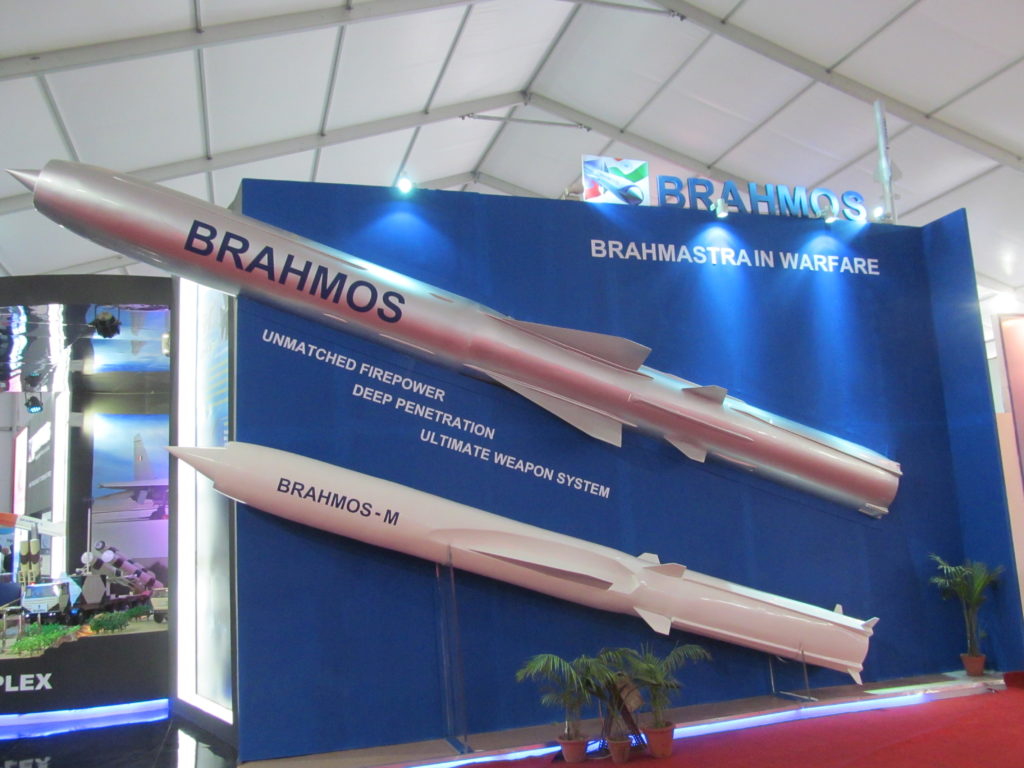
Brahmos 2 will be a hypersonic variant, with a maximum speed of Mach 7 and a range of 450-600 km as per Wikipedia. Its possible that Brahmos 2 is based on the hypersonic Zircon missile being developed by Russia. This is because NPO Mashinostroyeniya, the Russian company developing Zircon, is also one of the partners of Brahmos Aerospace. Both Brahmos 2 and Zircon missiles will use a scramjet engine, as opposed to the ramjet engine used by the current Brahmos and P-800 missiles.
However, as of now there is very little publicaly available information about the status of work on the Brahmos 2, and development of Zircon is reportedly facing technical obstacles. The hypersonic cruise missiles being developed by the US and China also haven’t finished development yet. So, it remains to be seen how long this class of missiles will take to be inducted in the world’s armed forces.

Conclusion
Brahmos Aerospace has so far been one of the most fruitful joint ventures between India and Russia. And the various variants of the Brahmos missile have single handedly increased the muscle power of all three arms of the Indian military. It has made it possible to hit land based targets deep inside enemy territory without personnel having to cross the border, will also enable hitting airborne targets from standoff distance, and has given the Indian navy and air force the ability to deter an invasion from the sea.
In addition to being a shot in the arm for the Indian military, Brahmos aerospace has also created an entire ecosystem of private and government facilities that make the various components of the missile system, generating employment and helping the Indian industry imbibe some very advanced technologies. And while the counter measures to supersonic missiles like Brahmos are being explored, the hypersonic version of Brahmos is being developed as well. So, for the foreseeable future, the prospects for this flourishing enterprise look bright.


